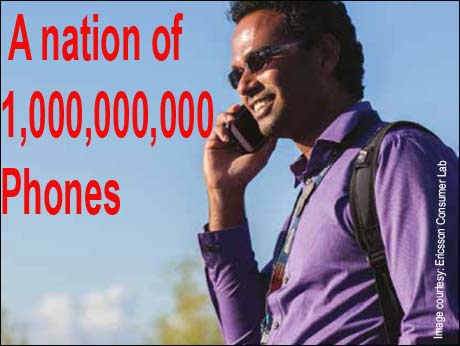
Special report
Bangalore, May 14 2015: Many regular readers of IndiaTechOnline tell us they find the Snapshot section amongst the most useful -- the corner where we summarise the numbers that define Indian IT -- then extrapoloate them using an algorithm we developed, to take note of the numbers released by multiple agencies. This allowed us on April 15 to quietly update the number of telephone numbers in India to 1 billion. Yesterday the official numbers released by the Telecom Regulatory Authority of India, corrected up to April 1, vindicates our finding and lends authority to the number we have posted this morning -- 1.01 billion. This includes a very small number of fixed lines. By June-July India will be a nation of a billion mobile phones.
One billion phones in a nation of 1.2 billion people might look like almost saturation coverage -- but let's not kid ourselves: that is hardly true ( there are a lot of multiple number holders). But it is reasonable for us to now say: Every Indian home has atleast one phone. This no mean achievement in empowerment. Correction: self empowerment. Around 12 years ago, the government quietly, cynically reneged on its promoise to use technology to help empower every Indian citizen with the means to connect, communicate and improve his or her quality of life. The decade gone by -- with two different governments at the helm, has seen little change in this scenario, where short term goals rarely extending beyond the expected life of one government have over ridden long term hopes of Indians lifting themselves to a better life. The recently concluded auction of telecom spectrum is just the visible in-your-face example of greed air brushing election promises, as government mopped up all the money it could from the sale of wireless spectrum with little thought for the social costs or the brakes this would put on empowerment through communication
The 19-day auction in early 2015 included some of the 'most wanted' bands—800 megahertz (MHz), 900MHz, 1,800MHz and 2,100MHz, which support advanced services such as 3G and LTE .There were eight telecom companies fighting for 20-year spectrum licences across four bands and 22 circles. The most sought after spectrum was in the 900 MHz band, with Bharti Airtel, Vodafone and Idea managing to retain their spectrum. Most players tried to enhance their 3G and 4G capabilities.
Reliance Jio aimed to achieve a nationwide 4G footprint by adding eight new circles in the 1800 MHz/800 MHz bands. It won six. All this came at a huge price: The auction finally saw government sell spectrum for over 1.1 trillion rupees ( Rs 1100 billion /Rs 1.1 lakh crore). The upfront payment alone which government has already realised exceed Rs 32 billion ( Rs 32,000 crores).
Some arm twisting by the Telecom Regulatory Authority of India has seen the major telecom providers slash roaming and SMS charges by around 40% This seems aimed at diverting attention from the inevitable increase in 3G and data rates once the service providers adjust to the reality of the huge cash outflows they have suffered.
The Indian mobile broadband landscape is evolving.An interesting study conducted by Ericsson shows that around one in three people are using smartphones in urban India.48 percent of those using mobile internet on 2G or 3G are unable to perceive any difference between 2G and 3G services. Some of the most widely used services on smartphones in India are for social networking and instant messaging. With 70 percent of users streaming videos and 40 percent streaming music weekly, entertainment services are also greatly valued.
Indian smartphone users are increasingly adopting online navigation, e-commerce and cloud storage services. 36 percent of urban mobile internet users access financialservices weekly on their smartphones.
The smartphone mobile broadband revolution in India began in key metropolitan areas, and continues to be dominant in these places. In contrast, smaller cities and towns have fewer entertainment options such as digital theatres, large retail chains and shopping malls.
Consumers in smaller cities and towns are rapidly embracing smartphones and mobile internet to bridge the gap and bring new, affordable entertainment. For many, mobile technology represents an easy to carry and less expensive alternative to other personal technology devices-- and ultimately to self empowerment.
The days to come will see -- we're betting -- much official self congratulation, as the '1 billion phones' fact sinks in. We believe this would be misplaced. At best only a small part of the credit should go to government.
Much of the credit needs to be directed at Indian private enterprise -- and international investment and partnership which made this country the launch-pad for many mobile technologies and services that are uniquely Indian.
And credit should go to the aam aadmi or lay Indian, who with little official encouragement or practical incentive seized on the cell phone as the single biggest tool to lift himself or herself up by the bootstraps. Who egged service providers to remain affordable, even as they rolled out services that Indians demanded and appreciated.
And yes, let's salute the unknown Indians who made their phones paisa vasool or money's worth by uniquely Indian spin-- like 'missed call!'
So let's say Jai Ho to -- us!
-- Anand Parthasarathy